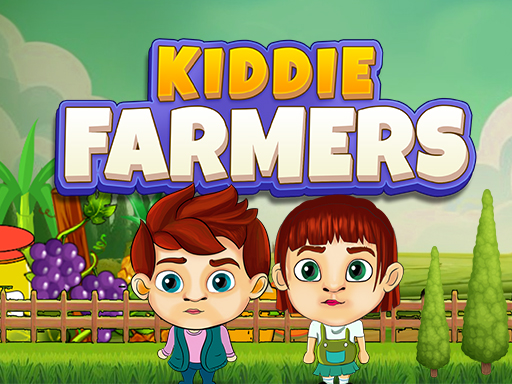
🌾🍎 Kiddie Farmer: Cultivate Fun and Business Skills in a Vibrant Farm-to-Table Adventure
Have you ever imagined being a young entrepreneur running your very own market while surrounded by golden fields and fresh produce? That’s the delight of Kiddie Farmer, a game that blends farming, business management, and strategy into a colorful, interactive world. Players step into the shoes of a kid CEO, managing farm operations, stocking a lively supermarket, and keeping their young customers happy.
In Kiddie Farmer, each decision matters. Do you plant more carrots or invest in berry bushes? Should you upgrade the checkout counters or expand your stall space? These choices create a sense of responsibility, pride, and engagement. Have you ever noticed how just the act of managing tiny operations can make you feel like a real-life business tycoon? That’s the subtle genius of this game — fun wrapped in practical skill-building.
The game encourages children to develop critical thinking, resource management, and coordination skills while having a blast. Parents can observe how their kids learn about patience, goal setting, and planning, making it both entertaining and educational. Every transaction, customer interaction, and crop harvest builds confidence and inspires creativity.
Game Mechanics: How Kiddie Farmer Works
Kiddie Farmer merges farming simulation with business strategy. Players cultivate crops, manage inventory, and sell products in a dynamic marketplace. The game’s main objective is to grow a small farm into a bustling market hub, satisfying customers while maximizing profits.
Controls and Interface
- Movement: Arrow keys for navigating the farm and market.
- Actions: Mouse clicks for harvesting, upgrading, and managing inventory.
- Interface: Simple icons for crops, upgrades, and transactions ensure accessibility for children.
This design allows young players to grasp the game mechanics quickly, while still offering depth for strategic decision-making.
Objectives and Progression
Players aim to:
- Plant and Harvest Crops: Grow vegetables and fruits efficiently.
- Manage the Market: Set up stalls, stock products, and keep shelves full.
- Upgrade Facilities: Improve equipment and store layout to boost efficiency.
- Attract Customers: Offer quality products and keep shoppers satisfied.
Levels increase in complexity with more crops, higher customer expectations, and competitive market scenarios. Successful management unlocks new crops, tools, and market areas.
Step-by-Step Strategy for Beginners
Starting out in Kiddie Farmer can feel overwhelming, but following a structured approach helps:
- Focus on Key Crops: Identify which crops are most profitable early on.
- Manage Inventory: Keep products stocked to avoid lost sales.
- Upgrade Gradually: Prioritize upgrades that improve production speed or storage.
- Observe Customer Patterns: Learn which products sell fastest at different times.
- Balance Workload: Rotate between harvesting, selling, and upgrading to maintain efficiency.
Here’s a table summarizing beginner strategies:
| Strategy | Benefit | Example |
|---|---|---|
| Focus on Profitable Crops | Maximize income | Plant berries first for higher sell value |
| Inventory Management | Avoid missed sales | Ensure stalls are always stocked |
| Gradual Upgrades | Efficient resource use | Upgrade water pumps before storage |
| Observe Customer Behavior | Target popular items | Stock juice stands during morning rush |
| Rotate Tasks | Avoid bottlenecks | Harvest while selling to maintain flow |
Following these strategies ensures smooth early gameplay and builds confidence for advanced levels.
Advanced Techniques for Optimized Management
Once comfortable with basic operations, players can adopt advanced strategies to maximize profits and efficiency:
- Crop Rotation: Plant high-demand crops based on market trends.
- Time Management: Schedule harvests and sales to reduce idle time.
- Strategic Upgrades: Focus on equipment that multiplies production capacity.
- Customer Segmentation: Offer specialized products for different age groups in the game.
- Expansion Planning: Allocate resources wisely when expanding the market or farm.
Have you ever noticed how tracking small customer habits can double your profits? Advanced players in Kiddie Farmer learn to balance production and sales with remarkable efficiency, almost like managing a mini economy.
Common Mistakes and How to Avoid Them
Even skilled young players can make errors. Awareness helps prevent setbacks:
| Mistake | Cause | Solution |
|---|---|---|
| Overplanting | Lack of storage or sell plan | Plant manageable quantities |
| Ignoring Upgrades | Short-term thinking | Prioritize upgrades that boost efficiency |
| Poor Inventory | Unpredictable sales | Track trends and adjust stock |
| Customer Neglect | Focused only on farming | Check stalls regularly |
| Rushed Expansion | Overextending resources | Expand gradually with sustainable plan |
Avoiding these pitfalls ensures smoother gameplay, happier customers, and faster progress.
Tips for Kids: Learning While Playing
Kiddie Farmer is perfect for children to develop a variety of skills:
- Math Skills: Calculating profits, pricing, and growth cycles.
- Critical Thinking: Deciding which crops to plant and when.
- Time Management: Coordinating multiple tasks efficiently.
- Creativity: Designing the layout of the market and farm.
Parents can ask interactive questions during play:
“Which crop do you think will sell fastest today, and why?”
“How could upgrading the stall help more customers buy products?”
This encourages reflection and learning through playful engagement.
For Adults: Strategic Planning and Cognitive Benefits
Adults can enjoy the game by focusing on optimization and multitasking:
- Production Efficiency: Maximize crop yield while minimizing idle time.
- Sales Strategy: Monitor trends and adjust product mix for higher returns.
- Resource Allocation: Balance labor, time, and upgrades effectively.
Advanced players might even track daily “virtual revenue” to improve decision-making and efficiency.
Visuals and Audio: Immersive Farm Atmosphere
Kiddie Farmer’s graphics are colorful and inviting. Fields are lush, crops are vivid, and customers are animated, creating a lively market scene. Smooth animations make actions like harvesting and selling satisfying.
Audio cues provide reinforcement: coins jingle when sales are made, water sprays when crops are watered, and cheerful customer reactions enhance engagement. Have you ever noticed how a simple sound effect can make a task feel rewarding? That’s the subtle genius of the game’s immersive design.
Rewards, Unlocks, and Motivation
Progression rewards keep players engaged:
- New Crops: Unlock vegetables and fruits with higher profits.
- Market Upgrades: Expand stalls, counters, and storage.
- Achievements: Earn badges for efficiency, high profits, and customer satisfaction.
- Daily Challenges: Encourage repeated play and skill development.
Motivation grows as players see tangible progress, fostering a sense of accomplishment and pride.
Emotional Engagement: Pride and Curiosity
Kiddie Farmer thrives on emotional engagement. Each successful sale or harvest fosters pride, while exploring new crops and upgrades sparks curiosity. Mini-anecdote: A young player once expanded the market strategically to sell smoothies during morning hours, discovering how timing and planning could dramatically increase profits — a delightful mix of learning and fun.
Players often reflect:
“How can I make more customers happy without overworking the farm?”
“Which crops give the best return, and how can I manage them efficiently?”
These reflections enhance engagement and reinforce problem-solving skills.
Tips to Maximize Fun and Success
- Balance planting and selling: Don’t focus on one to the detriment of the other.
- Upgrade wisely: Focus on tools and stalls that improve efficiency first.
- Observe market trends: Adjust crops to maximize profits.
- Engage with challenges: Daily objectives enhance skill-building.
- Replay levels for mastery: Perfect timing and layout designs improve performance.
Bullet-point summary:
- Track profitable crops
- Keep inventory stocked
- Upgrade facilities strategically
- Monitor customer behavior
- Replay for efficiency and mastery
Multiplatform Access
Kiddie Farmer is accessible on PC and mobile devices, with arrow keys and mouse for PC and touch control for mobile. This ensures flexibility and makes the game approachable for children and adults alike.
Educational and Cognitive Benefits
Kiddie Farmer strengthens cognitive, strategic, and social skills:
| Skill | Benefit in Game | Real-Life Application |
|---|---|---|
| Math & Calculation | Pricing and profit optimization | Early numeracy and budgeting |
| Planning & Strategy | Crop and market management | Project planning and resource allocation |
| Time Management | Coordinating multiple tasks | Efficient multitasking |
| Creativity | Market and farm layout design | Design thinking |
For more insight on learning through interactive games, see National Geographic Kids for research on engagement and skill development.
Conclusion: Grow, Sell, and Thrive in Kiddie Farmer
Kiddie Farmer isn’t just a game; it’s an engaging experience where children and adults cultivate skills, develop strategy, and enjoy the satisfaction of running a vibrant market. From planting crops to managing inventory, every choice teaches planning, coordination, and creativity.
Whether for educational purposes or pure entertainment, Kiddie Farmer combines fun, strategy, and learning in a colorful, interactive world. Step into the shoes of a young entrepreneur, grow your farm-to-table empire, and watch your efforts flourish in this delightful adventure.
For Your Social 🌾🍅
#KiddieFarmerGame #FarmToTable #KidsLearning #EntrepreneurKids #InteractiveGaming #FarmSimulation #StrategyAndFun #BusinessSkillsForKids #GamingEducation




